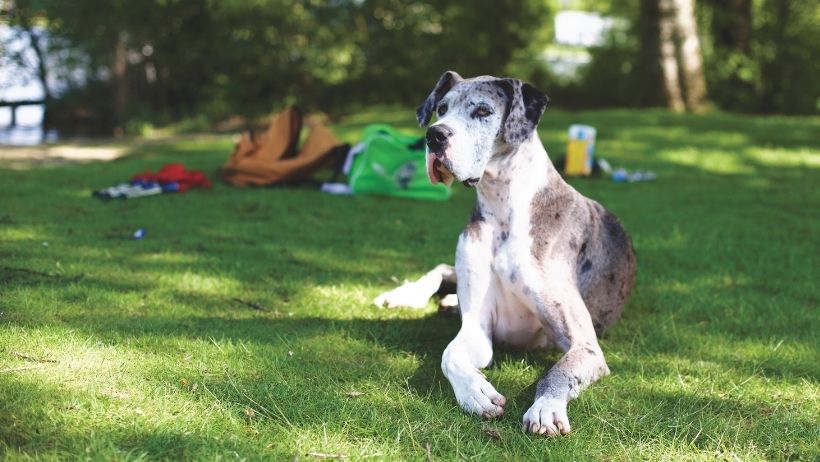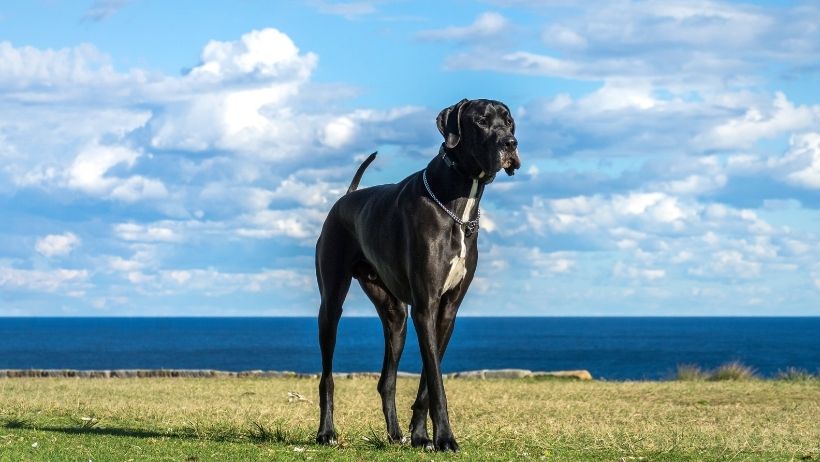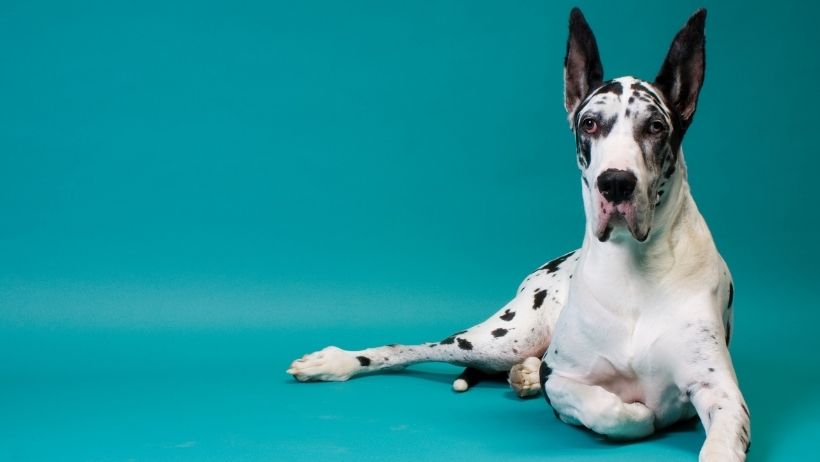Great Danish - Discover its history, characteristics, appearance and health of this race
The Great Danish or German Dogo, which is the other name with which this race is known and the one that is usually used, It is a huge size dog, the largest in the world and that guy who draws attention wherever he goes.
Although its appearance is imposing, the truth is that it is a friendly and noble animal, ideal as a partner whenever we have plenty of space and do not mind spending money on its support.
- Size: 76 cm females and up to 81 cm males.
- Weight: The range goes from 45 to 59 kilos, but males that reach 80 are not rare.
- Hair type: Short, very easy to take care of.
- Character: Affable, with little tendency to bark and very dependent on its owner. Health: We can qualify it as regular. Very conditioned by its enormous size.
- Life expectancy: from 6 to 8 years, although the specimens that do not reach six are not rare
History of the Great Danish
As in most races, there are those who say that in Egypt there are paintings in which dogs similar to the great Danish appear, although the truth is that they had little to do with this race, apart from being thin and large.
The most credible story tells us that Its origin dates around four centuries in an area that covers both Germany and Denmark and hence the name with which it has been known for years, and with which he is still appointed especially in Anglo -Saxon countries.
Apparently, its characteristic appearance comes from the crossing between mastines and lebre them, with the idea of being able to have a powerful and at the same time fast dog, something that is still done today in the rehala, where mastiffs and podencos are mixed.
The first news that we have of a dog that already resembles the current German gangster dates from the 18th century, where the nobility used them to keep their farms and even their carriages when they moved, which was a sign of prestige.

Already in the nineteenth century we can see the first representations of the great Danish similar to the current one, and in fact there were famous characters such as the Chancellor of the German Empire, Otto von Bismark, that had dogs of this breed for about six decades.
Becoming an animal related to the nobility is what saved him from disappearing, as happened with other races, when firearms widespread and dogs became less and less necessary in the guard and defense of properties.
Together with this, there is the one that there has been no “re -breeding of the race” since it has not been necessary, something that has happened in other races that have come to the present day after looking for the last specimens and making crosses.
As for the name of German Dogo, it seems that it comes from an exhibition that was made in 1876 and in which the judges proposed it, something that has been generating controversy since then, because in many places it is still known as great Danish.
Anyway, the truth is that the union of Germany with this breed is very narrow, since this was where the first club of the breed was born in 1888.
Great Danish characteristics
It is a perfect company dog, a quiet and very affectionate animal with its master, so much that it is not a dog that can be alone for a long time, since it will always look for the company of its owner.
They are usually a bit third and because of their size it is convenient to educate them very well since they are very young, which will help us in handling.
With strangers it is reserved, but never aggressive and the same goes for other dogs, since we could say that it is aware of its size and does not need to bark or teach the teeth to impose respect.
There is no problem that he lives with children or with other pets, because he tolerates the games very well, to throw his ears, etc., although here you have to be careful with size, especially when they are puppies and do not measure their strength well.
We can use it in the guard, although it is not a dog that has instincts for it. Here his great asset is the size, so much that it is not uncommon for people to cross as a sidewalk when they see us "just in case", although this dog will never attack anyone for no reason.
Aspect
Its appearance is what defines it, then The males weigh 90 kilos and measure 80 cm To the cross, which means that from your head to the ground there can be about a meter high.
When people who do not know the breed and see it attention how it moves, because it is not a mole of the type of clumsy movement masts, but they have the elegance of a lebrel and we are not wrong to say that it is majestic.
On the colors, the standard recognizes three mantles that should not be mixed. One is the lumid atheded, the other sprinkled and black, where we find the one that is the most spectacular variety of the race, the Dogo Arlequín and finally the blue, with much the tone that gives it greater elegance.
Until a few years ago they cut their tail and ears, which gave them an aggressive appearance that does not correspond to the character of the race, while now these mutilations are prohibited and that makes this huge dog look more friendly.
Great Danish health
If we are looking for a weak point of this race is in health, since 30% of the specimens do not live for more than five years and there are very few exceeding 10, although the latter is common to all large races.
The Hip dysplasia It is the most frequent problem, again as in all large and giant races, so you will have to be very attentive to this aspect and acquire certificate dogs, with which we minimize the risk, although it is always there.
Do not forget that dysplasia, in addition to coming by inheritance, can also arise for environmental reasons, so that veterinary control has to be strict in the growth stage.
We will also have care with the stomach torsion, an acute and very serious problem in which the stomach turns, literally. It can lead to the dog to death and prevents it by putting food to adequate height and dividing the rations.
It is prone to bone cancer and heart problems, although this should not scare us when buying one, since all races, even the smallest, have their own diseases or that usually suffer more frequently.
In order to have a dog as healthy as possible, it is best to buy it to a breeder to give us the maximum guarantees, such as the ancestors are free of dysplasia and that can provide us with DNA tests in which to see that there are no latent genetic diseases.

Breeding
When raising it, the first thing to consider is your health above all, controlling genetic diseases very well and renouncing some characteristics such as a strong jaw, if we know that we favor the Dogo Nursing of conjunctivitis permanently.
Aggressive dogs must be discarded, although they do not usually appear because it has been selecting more than a century to be close to people, as a huge size dog.
Its offspring is not complicated, and those dedicated to it usually say that it is easier than with mini dogs, although Yes, you have to be far from the female, because because of the size of the puppies, it is normal for them to be born through a caesarean section.
Due to the weight of the mother and puppies it is a very expensive breeding, which, as future owners of a German Dogo, is very good for us, since only the authentic fans are raised, because it is almost impossible to earn money with them.
Anyway, if we want to buy one, the best thing is that we go to the Spanish club, since here they can advise us and even have a DNA record of their dogs in order to control as much as possible the appearance of diseases.
How do you train a great Danish?
A great Danish has to start his education as soon as he gets home, since he is very stubborn and his size does not help try to handle him because we are not going to be able to pull him or lift him.
So, From an early age you have to teach him to get into the car for himself, to enter the bathtub, and above all not to throw, for which we can help ourselves a necklace against the pulls (never with a punishment or strangulator necklace).
We must not forget basic education, with orders such as sitting, lying down, staying still or coming to the call, insisting a lot that walking with the belt without pulling and always to our path.
We must completely leave violence, which, although we must never use it to train a dog, it does not suit us when we talk about animals with this physical power. Our best ally will be the treats, especially at the beginning, to reward with caresses over time.
They can be something "big heads", so we have to arm ourselves with patience and be firm, looking for professional help if we see that the situation surpasses us and because of how it is, it is best to make short sessions so that it does not get tired or distracted

What should I keep in mind if I want a great Danish
Taking into account your physique is not a dog for beginners. Thus, if we have never had a dog, we better opt for another more manageable and simple race to maintain, because the great Danish is an animal for people with a lot of experience.
The space is another of the conditions when it comes to taking a German Dogo home, and that its 80 kilos make it advisable to live on a floor, however great it is, and the same happens with the city.
It is an animal that needs large spaces, which cities cannot provide, so To be comfortable we must live in the field, in a town where we have access to large extensions where you can exercise and run free without throwing anyone to the ground.
Our economy must be very sanitized in order to be able to have it as it deserves, eating a I think of great quality (essential for it to grow without problems) that can cost us about 150 euros per month.
To that we will have to add the visits to the veterinarian, which will be frequent and that when you need medicines they will be the most expensive by having to give several tablets, since dog medications are administered according to weight.
In order to move it, the size of the car will also be a condition, due to the fact that it does not fit in the utilitarian classic. Perhaps removing the rear seats and the trunk tray can enter inside, but then our car will become a two seats without a trunk.
We talked about the importance of training and avoiding the pulls, but despite this It is convenient that the person who takes him out to the street has physical strength and can control it at all times.
Its 80 kilos are not easy to hold and we must not forget that despite education it is an animal and obeys its instincts, which can be scared, get nervous and get through complicated situations that we can only solve if we can retain it.
Other dog breeds that can be of interest:
Share
